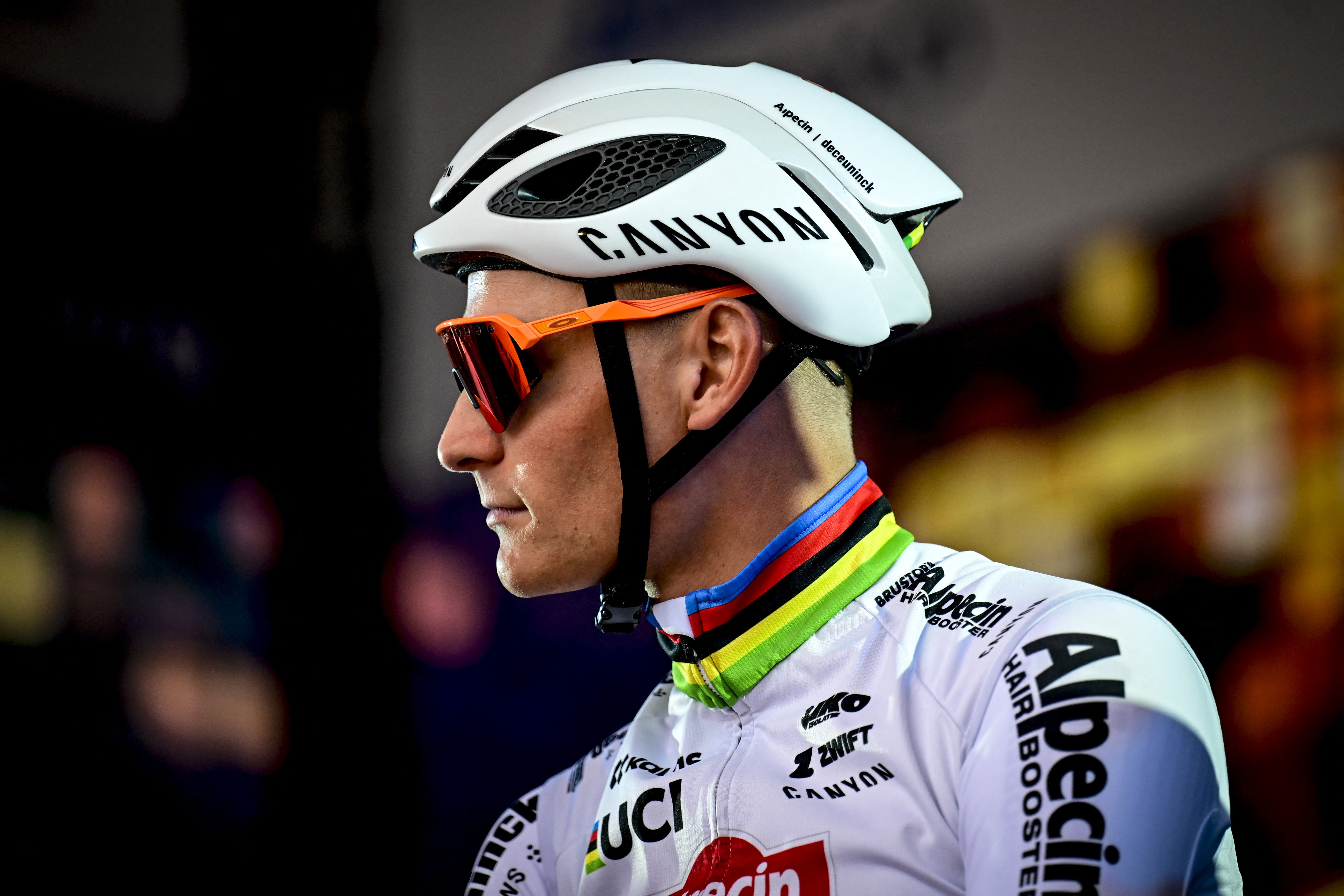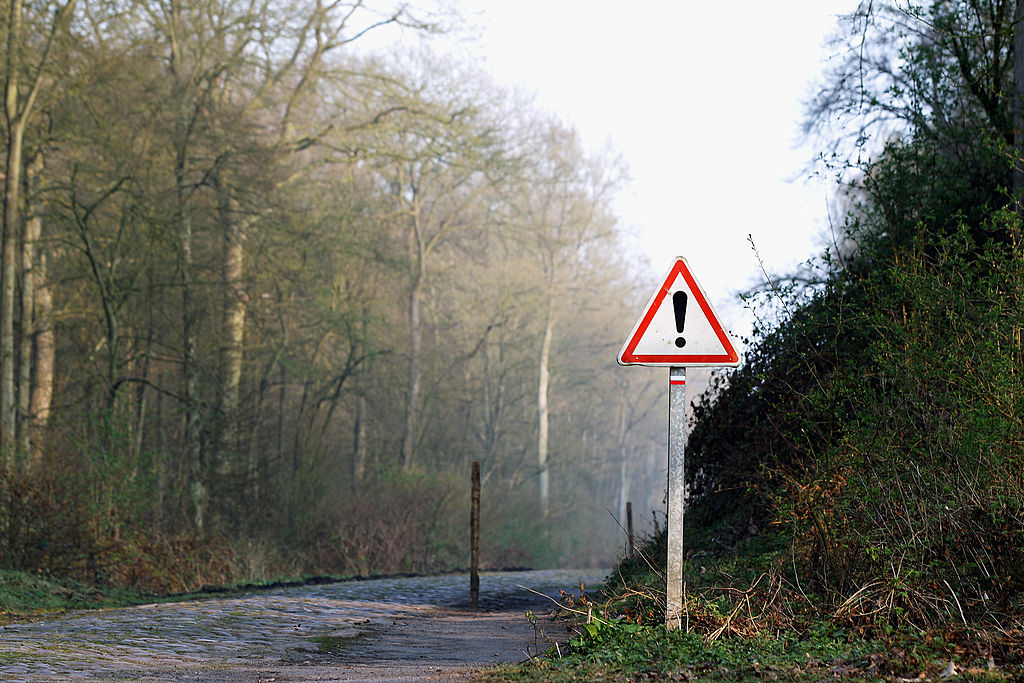Mathieu van der Poel: The most dangerous part of cycling is the riders, we take the risks
World champion highlights the risk of using aero road bikes and the chicane at Paris-Roubaix

Safety, crashes, cobbles and chicanes were discussed as much as winning Paris-Roubaix and a third monument Classic of the spring when Mathieu van der Poel and Jasper Philipsen spoke before a final recon ride on Friday morning.
The Alpecin-Deceuninck riders have dominated the Classics in recent weeks, winning Milan-San Remo, De Panne, the E3 Saxo Classic and the Tour of Flanders. They finished one-two at Paris-Roubaix in 2023 and seem poised to dominate the race again.
Following the terrible Itzulia crash, however, and the absence of Wout Van Aert after his high-speed crash at Dwars door Vlaanderen, Van der Poel and Philipsen are the only riders in the top nine in the UCI rankings not injured and out of action. Safety and finding the right solutions to protect the riders is on everyone’s mind.
“It's so shit to see a lot of our opponents and a lot of other guys dealing with bad luck at the moment,” Philipsen said, showing true solidarity between the riders.
“The verdict is quite hard for a lot of guys, they're out for a few weeks or months. As a team, we’ve avoided all the bad luck, which is in our favour. We’ve been fortunate.”
Van der Poel is pragmatic about safety. His cyclocross handling skills and power help him stay safe but he is fully aware of the dangers.
He has his opinions but does not want to be the spokesperson for the peloton or a leader on safety matters. He is happy to respect the rider team consultation process created by the CPA and their decisions.
Get The Leadout Newsletter
The latest race content, interviews, features, reviews and expert buying guides, direct to your inbox!
“You can do a lot of things to make things better but they will never be completely safe in my opinion, which is a shame,” he said.
“The most dangerous part of cycling is the riders, we take the risks. I also take risks because I also join the party. If you want to win, you have to be there. That's the problem. Everybody wants to be in front at the same point and it's just not possible.
“The SafeR project is trying to think about solutions but it's super difficult because we are racing on open roads. Last year, the Tour de France finish on the motor racing circuit was, for me, one of the most dangerous finishes I've ever seen. So that's also not the solution. I don't know if there is one.”
Road bikes for Paris-Roubaix?

Both van der Poel and Philipsen highlighted how bike design has changed racing and rider safety in recent years, especially for extreme cobbled races like Paris-Roubaix.
Most teams will forgo the comfort of ‘Roubaix’ bikes this year and ride their usual road bikes on Sunday, fitted with 32mm tubeless tyres.
Aerodynamics and speed are preferred over comfort, shock absorption and better bike handling. Tubulars have been sacrificed for the speed of tubeless, despite them offering better safety and slower deflation in the case of a puncture.
“I think the cobbles are not meant to be ridden on a road bike,” Van der Poel said bluntly. “The other cobbled sectors are quite bad, but rideable. Going into Arenberg at 65 km/h has nothing to do with bike skill, it’s just hoping the bike holds it.”
Philipsen highlighted the difference between a tubular puncture and tubeless puncture.
Special inserts can help reduce the impact of a tubeless puncture suddenly going flat but if the tyre and insert then come off, it can cause a sudden crash or destroy a carbon fibre rim.
“If you go into Arenberg at 60 km/h and you hit a stone, even somebody with really good bike skills can still have a flat tyre,” Philipsen suggested. “Then it's really hard to stay upright because of the speed and the loss of grip. Even the best bike handler will probably crash.”
Van der Poel, arguably the best bike handler in the sport, agreed.
“If a tyre goes flat, it's just super difficult to keep the bike straight,” he said.
The chicane is no joke

Van der Poel poured fuel on the fire as the debate about the Paris-Roubaix chicane blew up by writing ‘Is this a joke?’ on social media when the chicane design was revealed.
Despite conversations with Adam Hansen, the head of the Cyclistes Professionnels Associés (CPA), the riders’ union, Van der Poel is still not convinced by the Forest of Arenberg chicane created for Sunday’s race.
Van der Poel would like to turn right into the famed cobbled sector rather than from the traditional straight high-speed road run-in.
“For sure, the Forest of Arenberg is one of the most dangerous sections we do in the race and in an entire year, even I don't really feel comfortable,” he admitted.
“So it's good that they try and think about something, but in my opinion, the chicane is not the way to go. And doing it the week before is also maybe not the best option.
“I think coming from the right is a good solution,” he said.
“Adam Hansen texted me and I’ve seen some options they have for the coming years, which look quite good, but in my opinion, the chicane is going to be even more dangerous.
“If you go into Arenberg in front, you're still in the race but if you enter the chicane in 20th position, you’ll be standing still and you’ll lose half a minute.
“I’m not afraid to give my opinion but if the rest of the bunch thinks something else, I'll just follow that. I’ll try to win Paris-Robaix with the chicane or without it. I don't really want to think too much about it.”

Stephen is one of the most experienced member of the Cyclingnews team, having reported on professional cycling since 1994. He has been Head of News at Cyclingnews since 2022, before which he held the position of European editor since 2012 and previously worked for Reuters, Shift Active Media, and CyclingWeekly, among other publications.